Long-forgotten “winter sports” history still lives in the Elberta Hills
By Andrew Bolander
Current Contributor
In the 1920s, Ragnar “Reggie” Robertson emigrated from his native Norway—where he had learned to “ski jump”—to the United States, eventually making his way to Benzie County and leaving a lasting impact on the “winter sports” scene here.
Having begun in Norway in the late 19th century, ski jumping later spread throughout Europe and North America during the early 20th century. In ski jumping, competitors try to jump the farthest after going down a hill on their skis and then over a curved ramp for the jump; each competitor’s “style” while in the air, along with other factors, go into their final score, as well as the length of the jump.

Robertson was an employee of the carferries of the Ann Arbor Railroad, which operated between Toledo, Ohio, and Elberta/Frankfort, Michigan—the Ann Arbor Railroad was about 294 route miles, plus there were ferry services across Lake Michigan, from Betsie Bay to Wisconsin and back again, from 1892 to 1982. Robertson worked in the deck department and in maintenance for years.
While living and working here, Robertson got an idea to increase the availability of outdoor winter sports.
Elberta Mountain Winter Sports Park was a combination of a ski jump and hills for skiing, sledding, and toboggan runs. It was located in the Elberta Hills, the sand dunes which rest between the Village of Elberta and Lake Michigan, across the road from what is now Betsie Bay Marina. The property was and is still owned by Sand Products Corporation, a sand-mining company out of Muskegon. Sand Products leased the Village of Elberta rights to develop the area for winter sports, as long as large amounts of sand would not be contaminated.
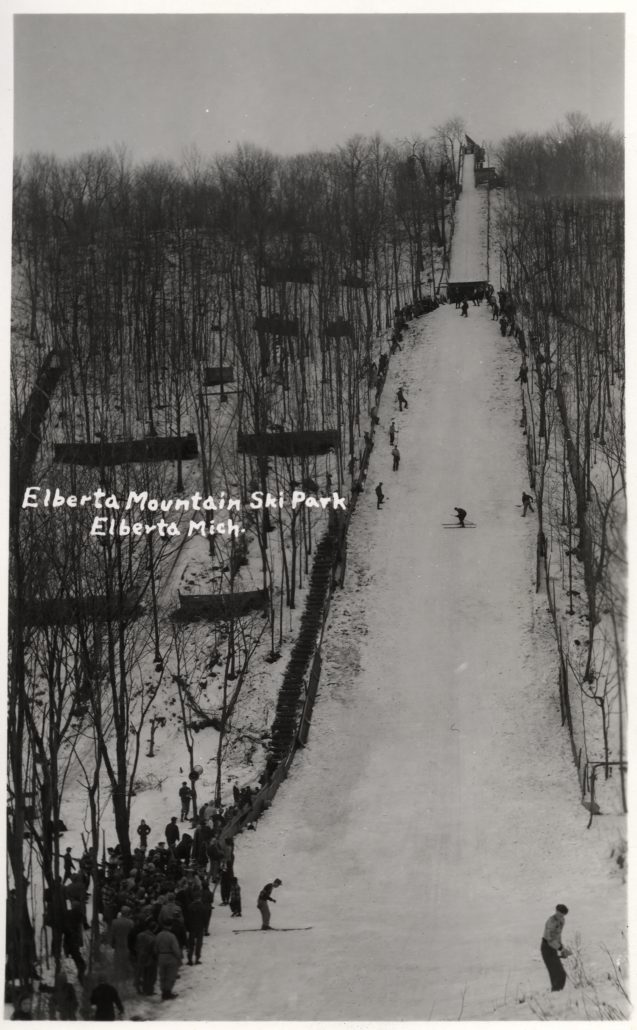
Robertson had selected the site along with his brother, Oscar Midland, who had been a member of Norway’s Olympic ski jumping team in 1928.
Some ski jumps are built using steel framing—perhaps some of you have visited “Suicide Hill” in the Upper Peninsula and have seen this type—but the Elberta ski jump is what is known as a “natural” ski jump, in that it used the natural environment already in place. (Of note: A 1951 article in the Benzie County Patriot says that Elberta’s ski jump was the “highest natural ski jump in the state of Michigan.”)
The only construction required for the ski jump was the approach for the jump. Robertson spent two weeks of his vacation clearing trees for the ski hill. The hill was given the unofficial name “Reggie’s Leap.” The valley below the jump was coined “McKee’s Pass,” in tribute to Max McKee, then-president of Sand Products Corporation. Robertson worked with Allen Blacklock, then-mayor of Elberta, and Gerald Vigland of the Elberta Mountain Ski Club (1951-1963), as well as many volunteers, to make the park operational.
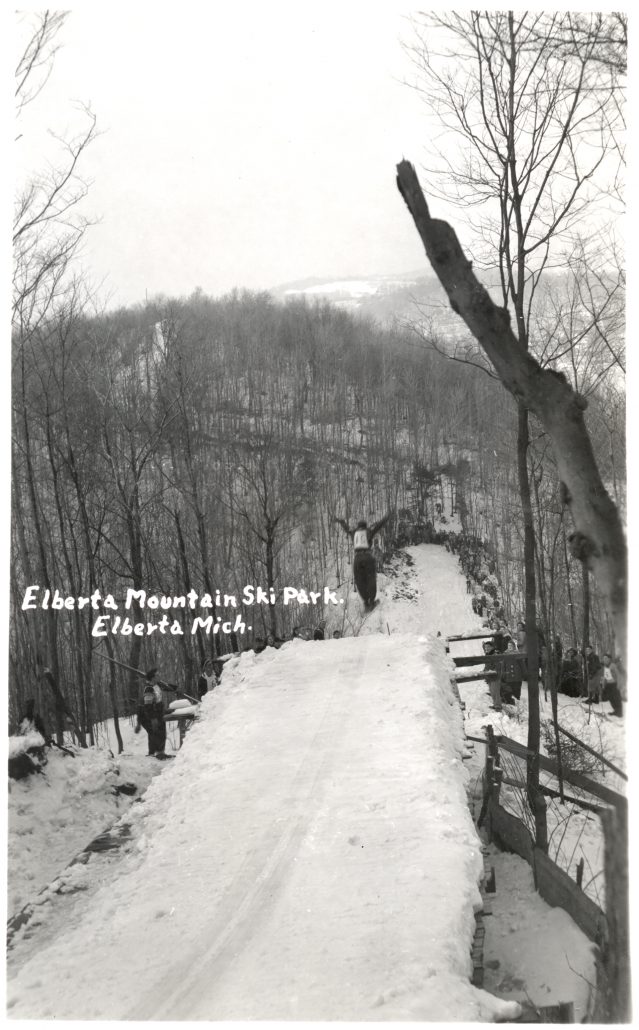
The creation of the park was announced in December of 1948 by the Village of Elberta. From the Traverse City Record-Eagle:
“A former ski-jumper, Ragnar Robertson, of Elberta, a native of Norway, single-handedly cleared a 600-foot slope which overlooks… Frankfort for a ski run. The jump will be 200 feet. Known as the Elberta Mountain Winters Sports Park, the ski run will provide recreation for those who have been wanting a good ski jump in this region.”
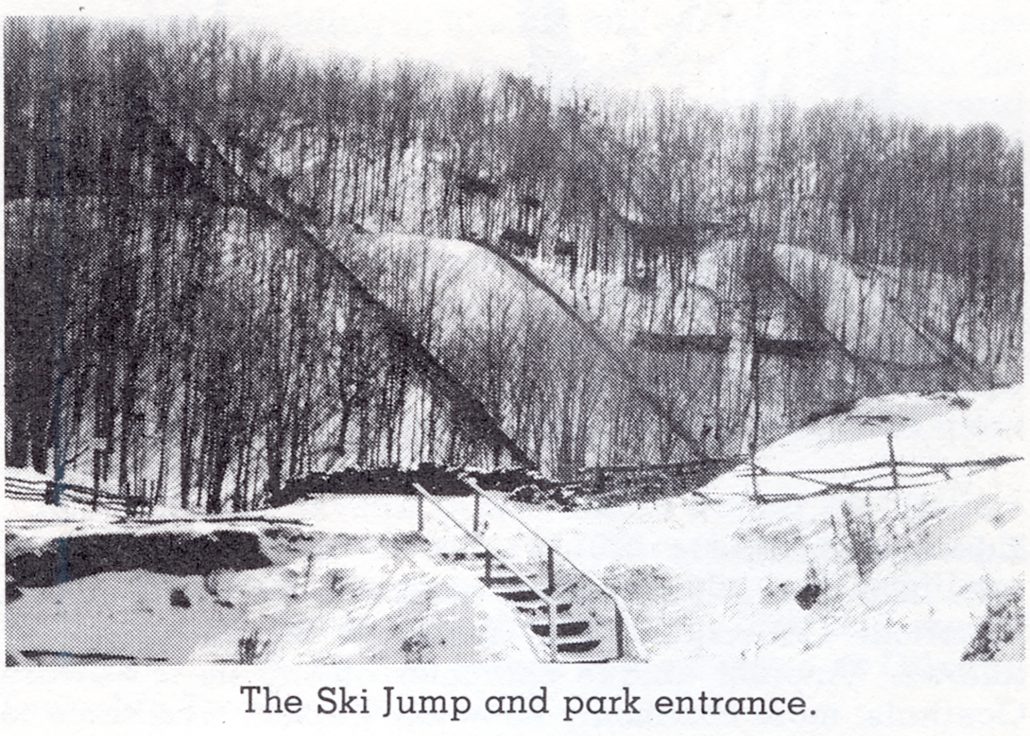
Interestingly, according to the Benzie County Record Patriot (February 2009), when the ski jump was completed in February 1950, Robertson had not done a proper ski jump himself since he had left Norway nearly three decades prior.
Cost of admission to the winter sports park varied and sometimes was not required; initially, a 50-cent admission fee was introduced in March of 1949, though that was gone by the mid-1950s.
Also from the Record-Eagle (January 22, 1954):
“Elberta Mountain Winters Sports Park will be open to the general public starting this weekend, every Saturday and Sunday throughout the season. No charges are made for the use of any of the facilities. For those seeking instruction, Ragnar Robertson, nationally known expert, will be on hand.”
The first annual Elberta Winter Sports Festival occurred on February 10 and 11, 1951. According to the Benzie County Patriot (February 15, 1951), the ski jumping competition was attended by “just about every ski-jumper of known ability” from the lower peninsula; jumpers competed from The Rochester Ski Club, the KanDaHar Ski Club, the Briar Hill Ski Club, the Kiwanis Ski Club of Iron Mountain, Norge Ski Club of Chicago, and the Elberta Ski Club.
Earl Hill and Walter Alexander of Briar Hill Ski Club in Mesick won the event with jumps of 151 feet; there was also a junior competition, won by high-schooler Roy Price from Elberta with 133 feet on Saturday, according to SkiSprungschanzen.com online. (He then also won the Sugar Loaf jumping contest the next day, on Sunday, in Leelanau County.)
Dubbed the “highlight” of the weekend, however, were Pudge LaPrarie and Junior Redman of Elberta on their toboggan; they claimed the “world toboggan jumping record” of 97 feet off the end of the ski jump, unless someone else could come forward saying that they had out-jumped them, wrote the Patriot at the time. (The weekend’s toboggan races were also won by Pudge LaPrarie.)
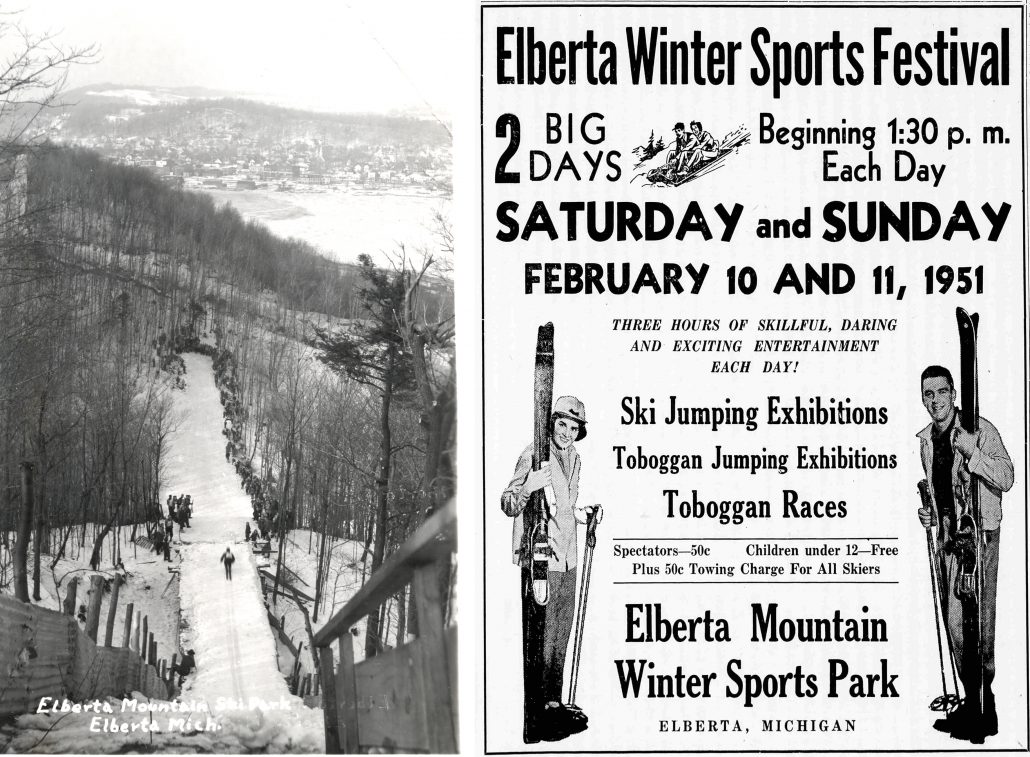
The Elberta Mountain Winter Sports Park was overseen by the Village of Elberta; it was supervised by Robertson and maintained and improved by the Elberta Mountain Ski Club.
The club—which had Robertson as its president and Gerald Vigland as secretary and treasurer—enabled the jumping events to be sanctioned by the United States Ski Association; that made events more appealing to jumpers from outside the area.
The community also provided room and board—as well as meals—to out-of-town jumpers, because many were amateurs and were unable to accept prize money.

Ski jumps were made when the weather allowed. It was estimated that 1,000 to 2,000 people would show up to events held during the early 1950s; many would eat large steak fries on outside fireplaces made of cement blocks, according to the Benzie County Record Patriot.
There were local jumpers, as well, which included: Earl Soderquist (who won the Michigan Intermediate Championship twice), Charles Luxford (who first jumped at age 12), Sandra Soderquist (who first jumped when she was 10), Gary Classens, Kenneth Anderson, Sharkey McConnell, Lawrence Price, Roy Price, Thomas Blacklock, and Douglas McDonald.
In addition to the ski jump, Elberta Mountain Winter Sports Park also featured a couple of ski hills, a toboggan run, two tow ropes, and a warming hut. Lights were added to the hill in 1954 for night skiing, sleighing, and jumper riding. Donated materials were used for improvements, which gave the park a unique appearance.
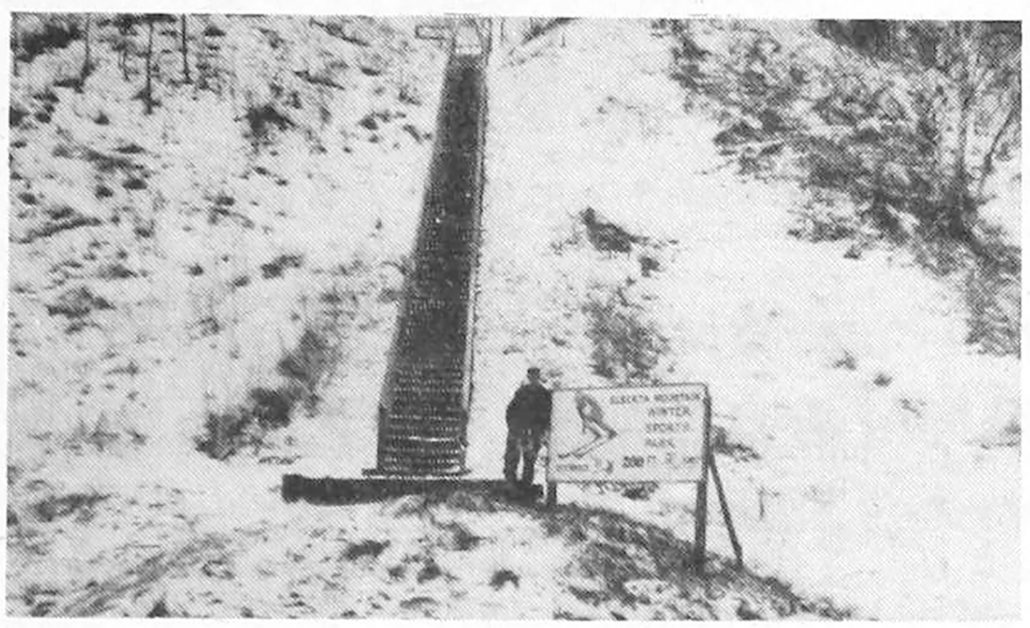
For instance, access to Elberta Mountain was via a staircase, which was made using old railroad ties that had been donated by the Ann Arbor Railroad. Used power poles and old auto wheels were employed for the tow system. Material for the warming hut was procured by the village and the South End Civic Club of Elberta. A motorized grader from the Elberta Department of Public Works spent the winters as a tow machine at the park.
Allen Blacklock wrote in his book The History of Elberta:
“Ropes and other valuable material were donated by Harlow Meno, although I don’t think he always knew it.”
From a “Guide To Michigan Skiing Centers” via the Lansing State Journal on January 2, 1955:
“Elberta Mountain – Within the village limits. Several runs and tows. Shelter house with lunch facilities. Two ski jumps. Tobogganing. For details: Ragnar Robertson, Superintendent, Elberta Mountain, Elberta.”
Elberta Mountain was still advertised as “open” as late as 1963, though the village officials let the park gradually phase out.
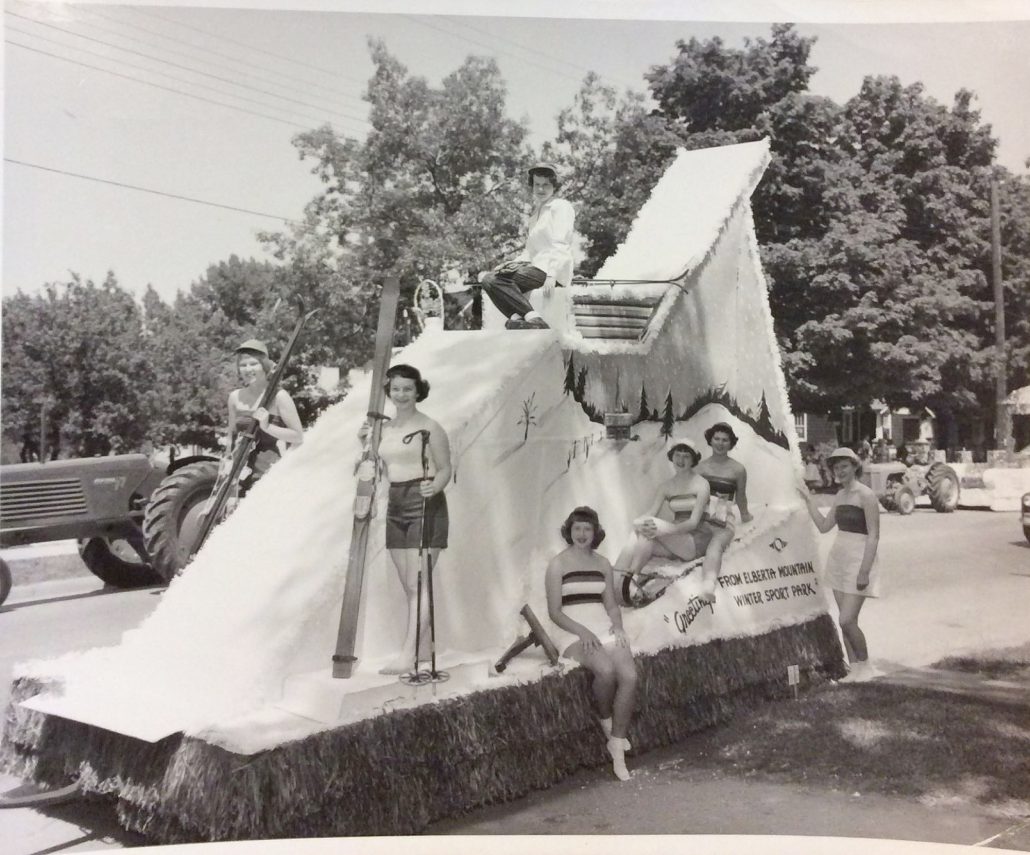
Though the Frankfort High School ski team would use the hill as a practice site, most activity had dwindled to weekend use, as other ski hills in the area gained popularity—Chimney Corners skiing had started in 1960 and Buck Hills, now known as Crystal Mountain, was established in 1955. Being located inland of Lake Michigan, Buck Hills in Thompsonville often received quite a bit more snow than Elberta. Additionally, there was a string of bad winters without a lot of snow during the early 1960s. This spelled doom for Elberta Mountain.
Nowadays, only a few relics of a Norwegian immigrant’s dream can be found in the forest behind Elberta.
“There are still quite a few pulleys for the rope tow, which are actually rims from car tires, mounted on poles. And down in the valley, there is a 1930s Chevy truck chassis,” Jerry Heiman of the Benzie Area Historical Museum, told UpNorthLive in December 2022. Of Robertson, he said:
“He was kind of a pied piper. So he got the local citizens to get on board, and they spent weekends clearing trees.”
Even today, intrepid winter-sports enthusiasts still roam the Elberta Dunes—but without a ski jump or a warming hut.
Editor’s Note: A reminder that the property was and is still owned by Sand Products Corporation, a sand-mining company out of Muskegon; it is private property and should not be visited by the public, without first gaining permission from the company.
Andrew Bolander is a volunteer with the Benzie Area Historical Society and Museum. The Benzie Area Historical Museum is open Wednesday, Friday, and Saturday afternoons. See upcoming events at BenzieMuseum.org and the continually updating catalog at BenzieMuseum.CatalogAccess.com/home online.
Many of our readers may remember sledding on the Elberta Hill as kids, back before the forest reclaimed it; however, if you were one of the few who did the ski jump, or had relatives who did, contact the Benzie Area Historical Society, as they may want to hear your story.
Featured Photo Caption: During the 1950s and 1960s, Elberta Mountain Winter Sports Park hosted toboggans, skiers, and ski-jumpers alike. Image courtesy of the Benzie Area Historical Society.
SIDEBAR #1
Ann Arbor Railroad’s Influence
The Ann Arbor Railroad—which operated between Toledo, Ohio, and Elberta/Frankfort, Michigan—was about 294 route miles, plus there were ferry services across Lake Michigan, from Betsie Bay to Wisconsin and back again, from 1892 to 1982.
The Ann Arbor Railroad was initially built to provide an alternative route to running freight through the rail yards in Chicago. At the time, railcars would take days or even weeks to travel through the busy Chicago yards, since a vast majority of East-West rail traffic was routed through Chicago.
The railroad’s impact on Benzie County was significant, and many aspects of our region that we enjoy today—more than 100 years later—are the results of the Ann Arbor Railroad. For instance, the railroad advertised our area as a vacation hotspot; built the 250-room Royal Frontenac Hotel, which was located directly on the beach in Frankfort; facilitated the growth of local agriculture and the fruit-processing industry; and connected Benzie County to the outside world.
Moreover, the villages of Thompsonville and Beulah were created by the railroads.
Furthermore, tourism is arguably the most important industry in Benzie County today, with hundreds of thousands of visitors each year, according to the Benzie County Visitors Bureau, and tourism started here because of the railroad.
When the Ann Arbor Railroad connected with the Frankfort & South Eastern in 1889 for through-traffic and with an actual purchase agreement in May 1892, it was a catalyst for development. Not only could our local residents more readily travel the greater world, but more people from the outside were able to discover what Benzie County had to offer.
Additionally, the launching of Ann Arbor No.1 and Ann Arbor No.2 carferries in the fall of 1892 were significant happenings at the time, earning mention in national newspapers like The Wall Street Journal and The New York Times. (Additionally, representatives from the British and Russian empires observed the operation of the carferries, to see if the idea would work in their home countries.)
The arrival of the Ann Arbor Railroad in 1892 was a major event, and the most immediate impact was jobs—the trains and carferries of the Ann Arbor Railroad provided steady work and eventually introduced the working class to organized labor.
Also, the AARR heavily promoted tourism, including lobbying for the Congregational Assembly to locate at Crystal Lake in 1904.
The AARR also provided a train in 1934 to carry 700 boosters from Northwest Michigan to Lansing so that they could lobby the State Highway Commissioner for the construction of M-115, a highway that now connects Clare and Frankfort, thus providing a popular route for vacationers to come to Benzie County from Southeast Michigan, then as now. These 700 boosters rode on 14 passenger coaches, and the participants unloaded and paraded down Michigan Avenue to Prudden Auditorium. The Clare-to-Frankfort diagonal (M-115) was completed in 1957.
Even the 1911 re-naming of Elberta—previously called “South Frankfort—is indicative of another influence of the railroad; Elberta was named for a peach which was grown in this area. The railroad allowed for companies like Armour Fruit Preservation and the Elberta Packing Company to preserve and ship the local crops. The orchards of this area thus experienced a boost when the railroad arrived.
A horticulturist with a national reputation named Paul Rose came soon after the railroad arrived, and he planted his orchard outside of Elberta. (There is now a Benzie County road named for Paul Rose, located between Grace Road and Herron Road, just southeast of Elberta.) Rose had revolutionary ideas toward the growth, storage, and shipment of fruit, and the proximity to the Ann Arbor Railroad was an important factor for his arrival to Benzie County in 1893. At the 1904 World Exposition in St. Louis, Missouri, Rose was awarded the gold medal for both his cherries and his apples—yes, the gold medal for fruit-growing went to Benzie County. And a strong ingredient to that success was Rose’s involvement in the packing and shipping of the submissions to the Exposition, via the Ann Arbor Railroad.
Added to the list of impacts is the fact that the Elberta Mountain Winter Sports Park owes its legacy to the Ann Arbor Railroad, as well; Ragnar “Reggie” Robertson emigrated from his native Norway to the United States, eventually making his way to Benzie County and building a ski jump and hills for skiing, sledding, and toboggan runs that ran for a couple of decades and brought even more tourists to our area.
SIDEBAR #2
Nordic Skiing (and Jumping)
Ski jumping is among the traditional group of “Nordic” skiing disciplines, which are various types of skiing—cross-country skiing, Telemark skiing, and ski jumping—in which the toe of the boot is fixed in a binding while the heal is free, unlike in “alpine” (also called “downhill”) skiing, in which the boot is attached to a binding from toe to heel. There is also a distinct difference between “ski jumping” and “ski flying”: jumpers follow the curve of the hill, usually no more than 10 feet off the ground, while fliers aim for much greater heights and distances.
“Since the dawn of history, northern Europeans have looked on skiing as more efficient than walking,” wrote Vivian M Baulch in The Detroit News (February 2002). “A museum in Stockholm, Sweden, claims to have a pair of skis that may be 5,000 years old. In the Middle Ages, armies proficient in the art of skiing controlled snow-covered areas of Europe. As skiing developed into a leisure-time activity, categories such as alpine and Nordic skiing evolved. But the most spectacular forms of skiing clearly are ski jumping and ski flying, thrilling not only to the jumper but to those spectators who brave the cold to marvel at the sight.”
The first ski-jumping tournaments in the United States were held during the 1870s and 1880s in Ishpeming, a small mining town in Michigan’s Upper Peninsula, near to Lake Superior.
Ski jumping is still an Olympic sport but is seen much less frequently in this century than the last, when it was not unusual to find ski jumps throughout the state of Michigan. (A somewhat-complete list follows, gleaned from Midwest Lost Ski Areas Project online; only a couple of these are still in use today.)
• Alpine Valley or Mt Grampian, White Lake – had jump in 1966 (no idea how long before/after that).
• Bloomer Ski Jump, Rochester Hills – built in 1928, converted in 1938, destroyed by a storm in 1940s.
• Briar Hill Ski Area and Jump, Mesick – had jump in 1951 (no idea how long before that) through at least 1959.
• Bright Ski Jumps, Brighton – built in 1935; dismantled and reconstructed two years later at the Bloomer Park/Rochester site.
• Caberfae Peaks, Cadillac – had jump in 1938 (no idea how long before/after that).
• Copper Peak, Ironwood – only “ski flying” facility in the Western hemisphere; built in 1969 for $1 million; Michigan State Historic Site since 1971; closed in 1994; often called “Suicide Hill.” (Beginning in 1935, Wolverine Hill had ski jumps on Copper Peak.)
• Crystal Falls Ski Jump, Crystal Falls – no information, other than there used to be a scafood where Crystella Ski Hills is now located, but the scaffold is long gone.
• Echo Valley, Kalamazoo – opened in 1934 as a ski-jumping area; closed ski jump in 2003; still open for tobogganing, tubing, and ice-skating.
• Elberta Mountain Winter Sports Park, Elberta – created 1948; closed in 1960s.
• Ford Mountain, Berrien Springs – operating in the late 19-teens or early 1920s.
• Forest Hills Ski Resort, Munising – old ski jump created in 1928; new ski jump created in 1967; closed in 1960s.
• Hotel Golfmore Ski Jump, New Buffalo/Grand Beach – held annual ski jumping tournament beginning in 1922; hotel burned in 1939; unsure when tow and rope were demolished.
• Grand Rapids Ski Club, Grand Rapids – jump built in Richmond Park in 1960.
• Grayling Winter Sports Park Ski Jump, Grayling – park opened in 1929; jump built in 1934; still in operations as late as 1942 (not sure if later).
• Ishpeming Winter Sports Park, Negaunee – ski jump built in 1925; still in use. (Notably, other hills were used in Ishpeming as early as 1882.) Also called “Suicide Hill.”
• Lake Shore Ski Club, Sault Ste. Marie – built in 1948
• Mt. Joy Ski Jump, Wakefield – no info.
• Pine Mountain Ski Jump, Iron Mountain – built in 1938; known as one of the best ski-jumping facilities in the world; holds the record for longest jump in World Cup competition at 459 feet and overall distance record of 472.44 feet (excluding “ski flying” hills); still in use.
• Pontiac Lakes – Kandahar Ski Club had a jump, before moving to Fenton location, which was built in1967 and torn down in late 1980s.
• Snow Valley, Gaylord – had jump in 1950s (no idea how long before/after that)/
• Spring Valley/Caspian Ski Hill, Caspian – built in 1940.
• Sugar Loaf, Cedar – had jump in 1951 (no idea how long before that)
• Wolverine Hill, Ironwood – Built in 1935, renovated in 1975, but later demolished.




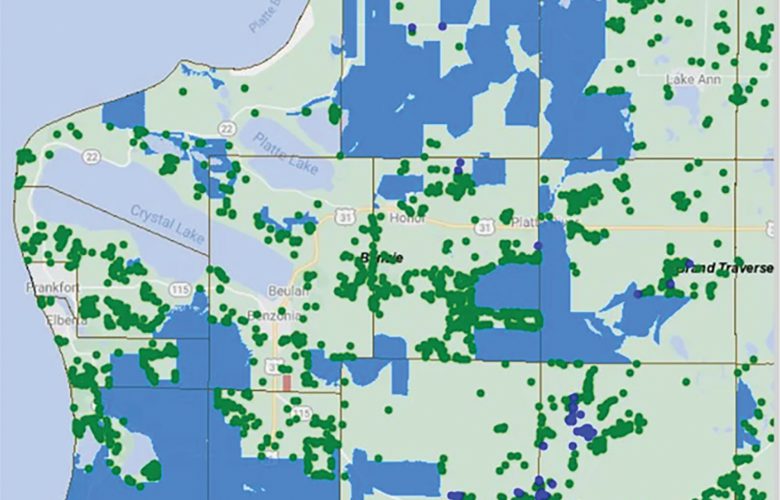
Excellent article.